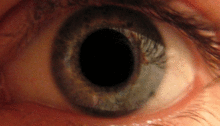Utilizator:MagnInd/RFPP

Pupillary Light Reflex is modeled as a physiologically-based non-linear delay differential equation that describes the changes in the pupil diameter as a function of the environment lighting[1]:
where is the pupil diameter measured in millimeters and is the luminous intensity reaching the retina in a time , which can be described as : luminance reaching the eye in lumens/mm2 times the pupil area in mm2. is the pupillary latency, a time delay between the instant in which the light pulse reaches the retina and the beginning of iridal reaction due nerve transmission, neuro-muscular excitation and activation delays. , and are the derivatives for the function, pupil diameter and time .
Since the pupil constriction velocity is approximately 3 times faster than (re)dilation velocity [2], different step sizes in the numerical solver simulation must be used:
where and are respectively the for constriction and dilation measured in milliseconds, and are respectively the current and previous simulation times (times since the simulation started) measured in milliseconds, is a constant that affects the constriction/dilation velocity and varies among individuals. The higher the value, the smaller the time step used in the simulation and, consequently, the smaller the pupil constriction/dilation velocity.
In order to improve the realism of the resulting simulations, the hippus effect can be approximated by adding small random variations to the environment light (in the range of 0.05 Hz to 0.3 Hz) as proposed by [3].
Note
[modificare | modificare sursă]- ^ Pamplona, V. F., Oliveira, M. M., and Baranoski, G. V. G. (2009). Photorealistic models for pupil light reflex and iridal pattern deformation. ACM Trans. Graph. 28, 4 (Aug. 2009), 106:1-106:12. DOI= http://doi.acm.org/10.1145/1559755.1559763
- ^ Ellis, C. J. (). „The pupillary light reflex in normal subjects”. British Journal of Ophthalmology. 65 (11): 754–759. doi:10.1136/bjo.65.11.754. PMC 1039657
 . PMID 7326222.
. PMID 7326222.
- ^ Stark, L. W. (1939). Stability, Oscillations, and Noise in the Human Pupil Servomechanism. Proc. of the IRE, [S.l.], v.47, n.11, p.1925–1939


![{\displaystyle {\frac {dM}{dD}}{\frac {dD}{dt}}+2.3026\;atanh\left({\frac {D-4.9}{3}}\right)=5.2-0.45\;ln\left[{\frac {\Phi (t-\tau )}{4.8118~\times ~10^{-10}}}\right]\;\;}](https://wikimedia.org/api/rest_v1/media/math/render/svg/15dfced06f1cff1f1b2a3708031643ee40cb9f92)















